1998 CADILLAC ELDORADO child lock
[x] Cancel search: child lockPage 32 of 380
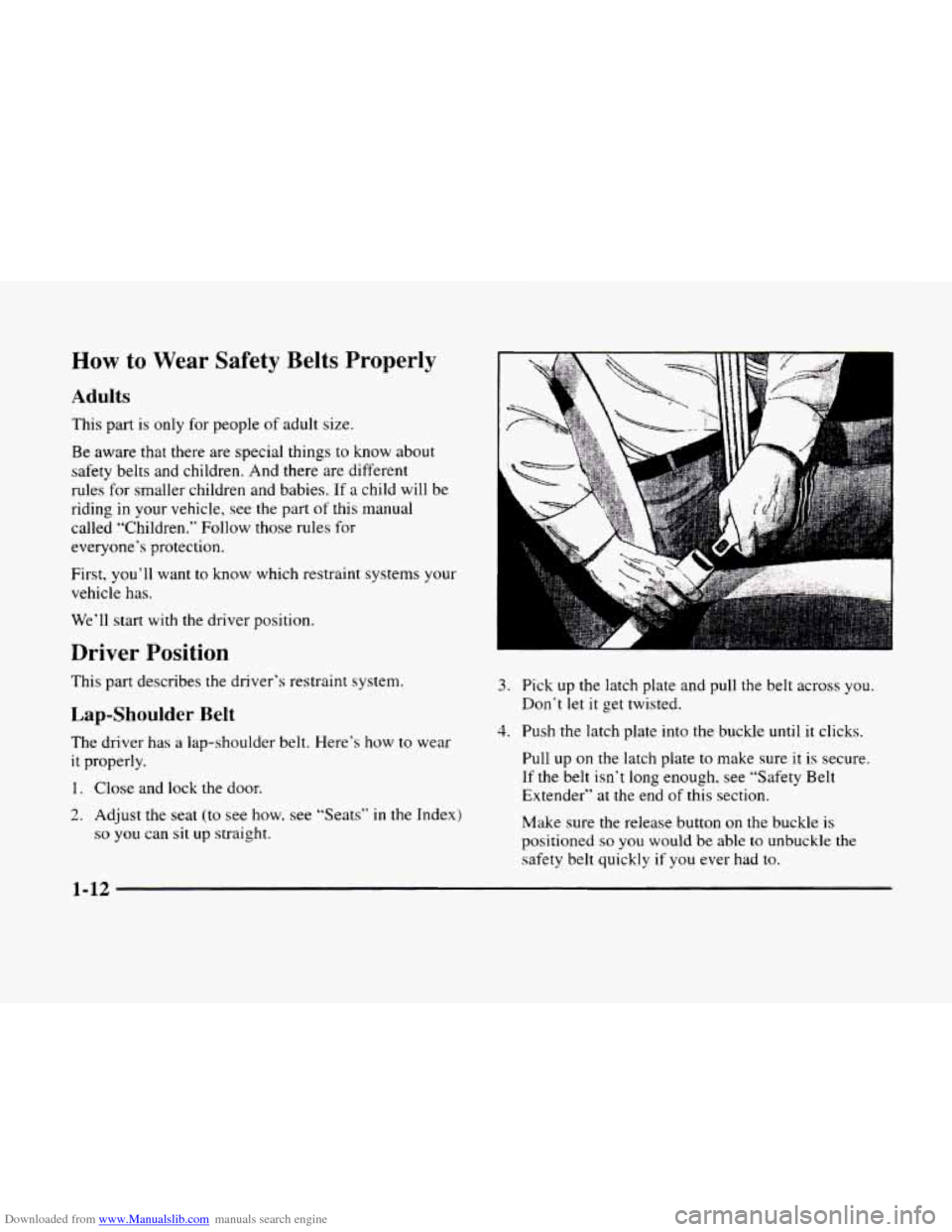
Downloaded from www.Manualslib.com manuals search engine How to Wear Safety Belts Properly
Adults
This part is only for people of adult size.
Be aware that there are special things to know about
safety belts and children. And there are different
rules for smaller children and babies. If
a child will be
riding in your vehicle,
see the part of this manual
called “Children.”
Follow those rules for
everyone’s protection.
First, you’ll want to
know which restraint systems your
vehicle has.
We’ll start with the driver position.
Driver Position
This part describes the driver’s restraint system.
Lap-Shoulder Belt
The driver has a lap-shoulder belt. Here’s how to wear
it properly.
1. Close and lock the door.
2. Adjust the seat (to see how. see “Seats” in the Index)
so you can sit up straight.
3. Pick up the latch plate and pull the belt across you.
Don’t let
it get twisted.
4. Push the latch plate into the buckle until it clicks.
Pull up on
the latch plate to make sure it is secure.
If the belt isn’t long enough. see “Safety Belt
Extender” at the end of this section.
Make sure the release button
on the buckle is
positioned
so you would be able to unbuckle the
safety belt quickly if you ever had to.
1-12
Page 40 of 380
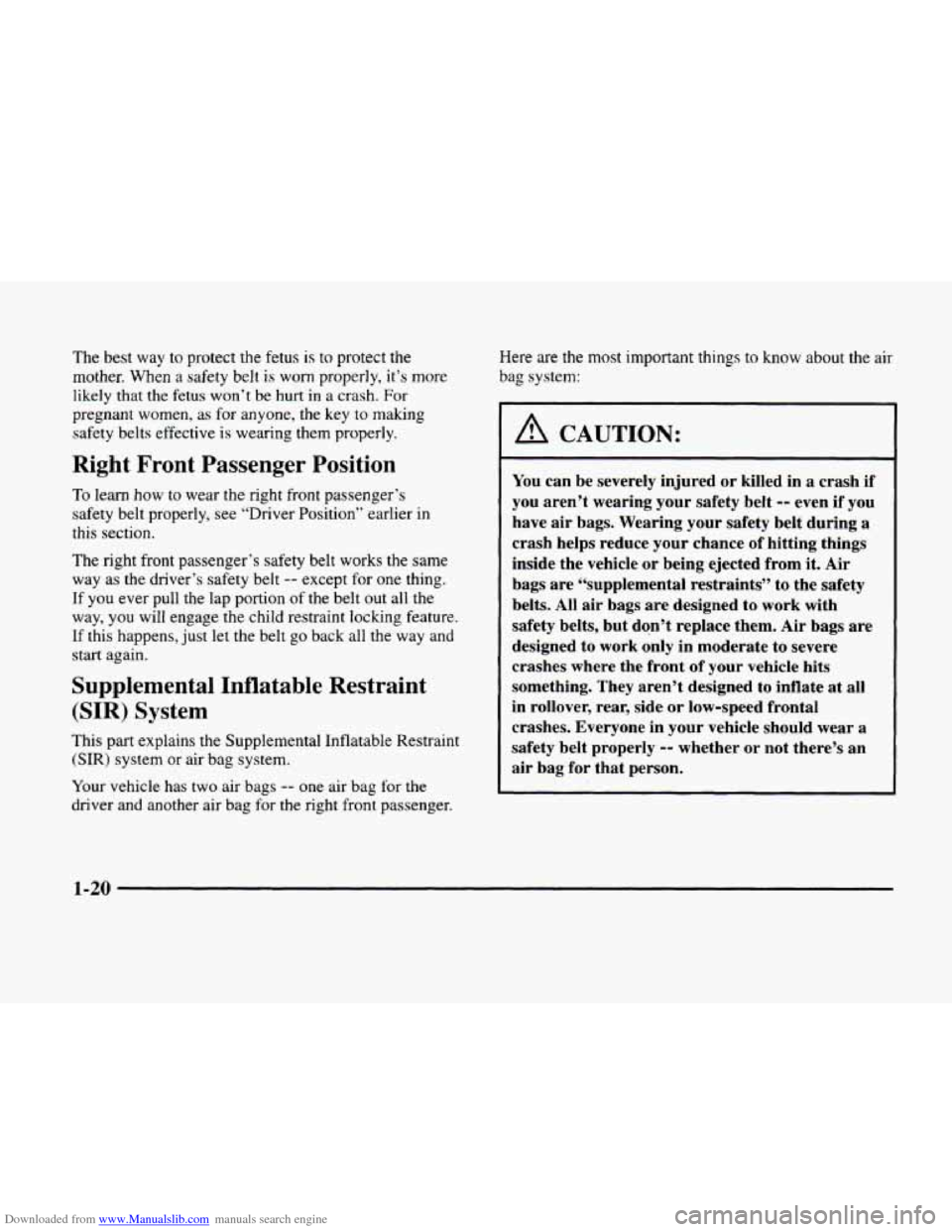
Downloaded from www.Manualslib.com manuals search engine The best way to protect the fetus is to protect the
mother. When a safety belt is worn properly, it’s more
likely that the
fetus won’t be hurt in a crash. For
pregnant women, as
for anyone, the key to making
safety belts effective is wearing them properly.
Right Front Passenger Position
To learn how to wear the right front passenger’s
safety belt properly,
see “Driver Position” earlier in
this section.
The right front passenger’s safety belt works the same
way as the driver’s safety belt
-- except for one thing.
If you ever pull the lap portion of the belt
out all the
way,
you will engage the child restraint locking feature.
If this happens, just let the belt go back all the way and
start again.
Supplemental Inflatable Restraint
(SIR) System
This part explains the Supplemental Inflatable Restraint
(SIR) system or air bag system.
Your vehicle has two air bags
-- one air bag for the
driver and another air bag for
the right front passenger. Here
are the most important
things to know about the air
bag system:
A CAUTION:
You can be severely injured or killed in a crash if
you aren’t wearing your safety belt -- even if you
have
air bags. Wearing your safety belt during a
crash helps reduce your chance
of hitting things
inside the vehicle or being ejected
from it. Air
bags are “supplemental restraints” to the safety
belts.
All air bags are designed to work with
safety belts, but don’t replace them. Air bags are
designed
to work only in moderate to severe
crashes where the front of your vehicle hits
something. They aren’t designed to inflate at all
in rollover, rear, side or low-speed frontal
crashes. Everyone in your vehicle should wear a
safety belt properly
-- whether or not there’s an
air bag for that person.
1-20
Page 74 of 380
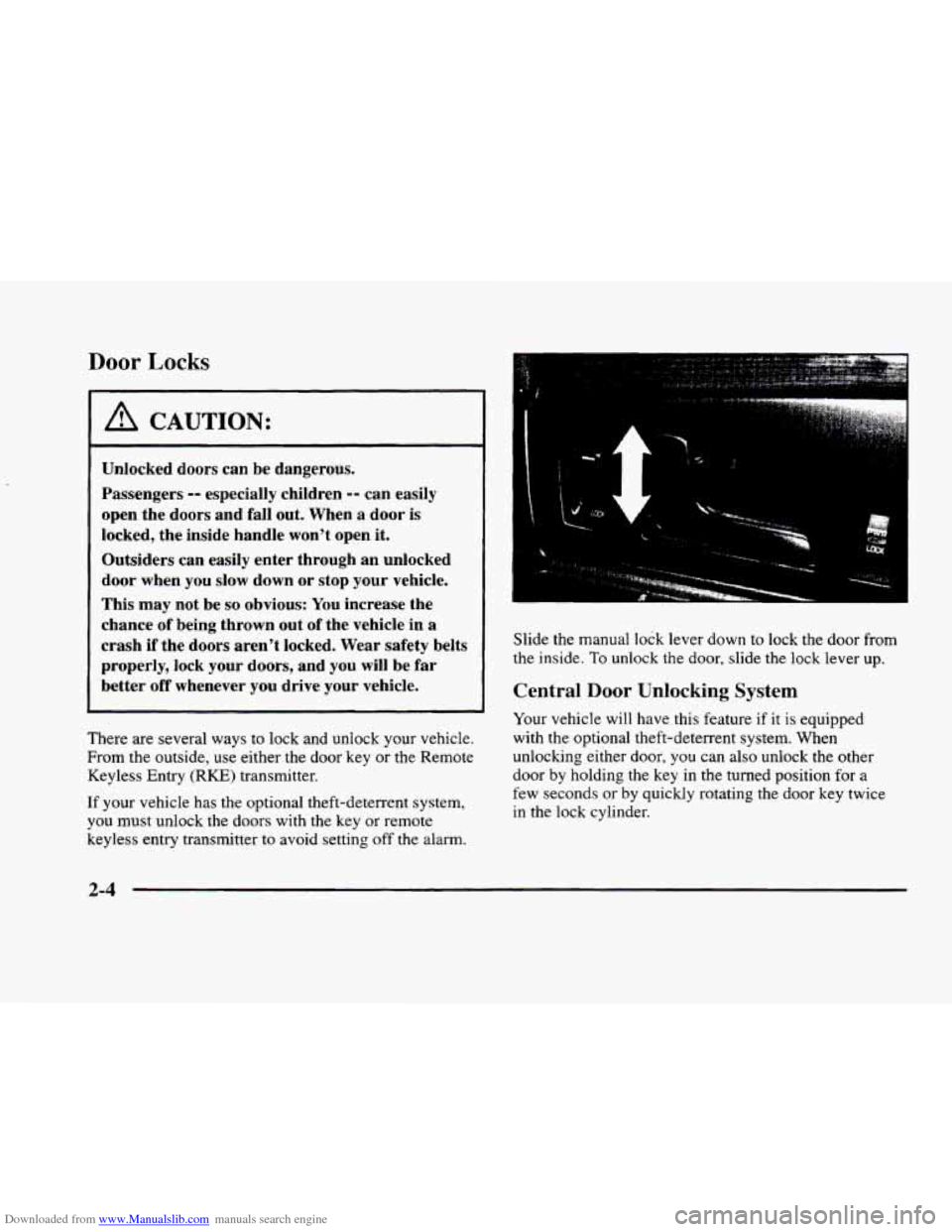
Downloaded from www.Manualslib.com manuals search engine Door Locks
I A CAUTION:
Unlocked doors can be dangerous.
Passengers
-- especially children -- can easily
open the doors and fall out. When a door
is
locked, the inside handle won't open it.
Outsiders can easily enter through an unlocked
door when you slow down or stop your vehicle.
This may not be
so obvious: You increase the
chance of being thrown out
of the vehicle in a
crash if the doors aren't locked. Wear safety belts
properly, lock your doors, and you will be
far
better off whenever you drive your vehicle.
There are several ways to lock and unlock your vehicle.
From the outside,
use either the door key or the Remote
Keyless Entry
(RKE) transmitter.
If your vehicle has the optional theft-deterrent system,
you must unlock the doors with the key or remote
keyless entry transmitter to avoid setting
off the alarm. Slide
the manual
lock lever down to lock the door from
the inside.
To unlock the door, slide the lock lever up.
Central Door Unlocking System
Your vehicle will have this feature if it is equipped
with the optional theft-deterrent system. When
unlocking either door,
you can also unlock the other
door
by holding the key in the turned position for a
few seconds or by quickly rotating the door key twice
in the lock cylinder.
2-4
Page 210 of 380
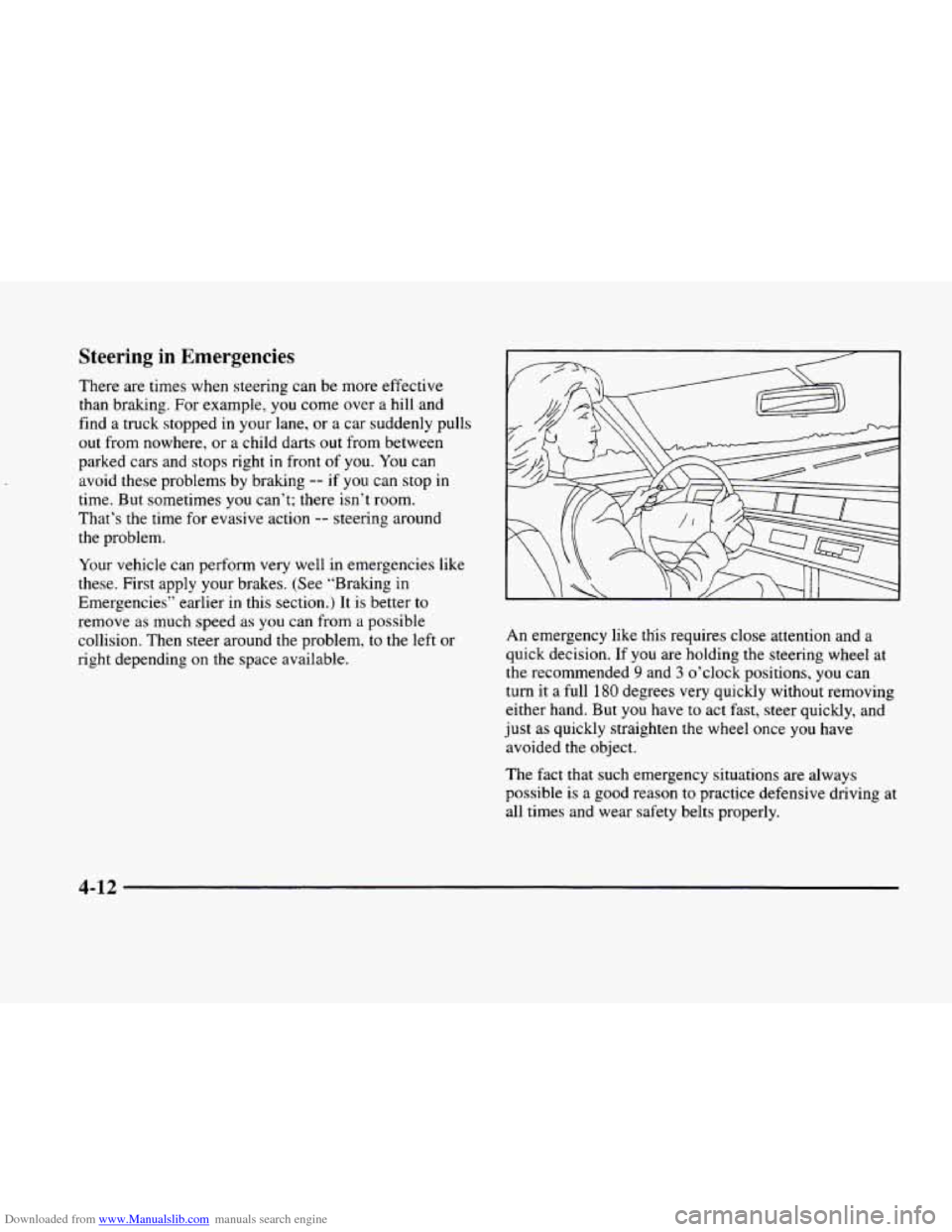
Downloaded from www.Manualslib.com manuals search engine Steering in Emergencies
There are times when steering can be more effective
than braking. For example, you come over a hill and
find
a truck stopped in your lane, or a car suddenly pulls
out from nowhere, or a child darts out from between
parked cars and stops right
in front of you. You can
avoid these problems by braking
-- if you can stop in
time. But sometimes you can’t: there isn’t room.
That’s the time for evasive action
-- steering around
the problem.
Your vehicle can perform very well in emergencies like
these. First apply your brakes. (See “Braking in
Emergencies’? earlier in this section.) It is better to
remove as much speed as
you can from a possible
collision. Then steer around the problem, to the
left or
right depending
on the space available.
An emergency like this requires close attention and a
quick decision.
If you are holding the steering wheel at
the recommended
9 and 3 o’clock positions, you can
turn it a full 180 degrees very quickly without removing
either hand. But you have to act fast, steer quickly, and
just as quickly straighten the wheel once you have
avoided the object.
The fact that such emergency situations are always
possible
is a good reason to practice defensive driving at
all times and wear safety belts properly.
4-12
Page 364 of 380
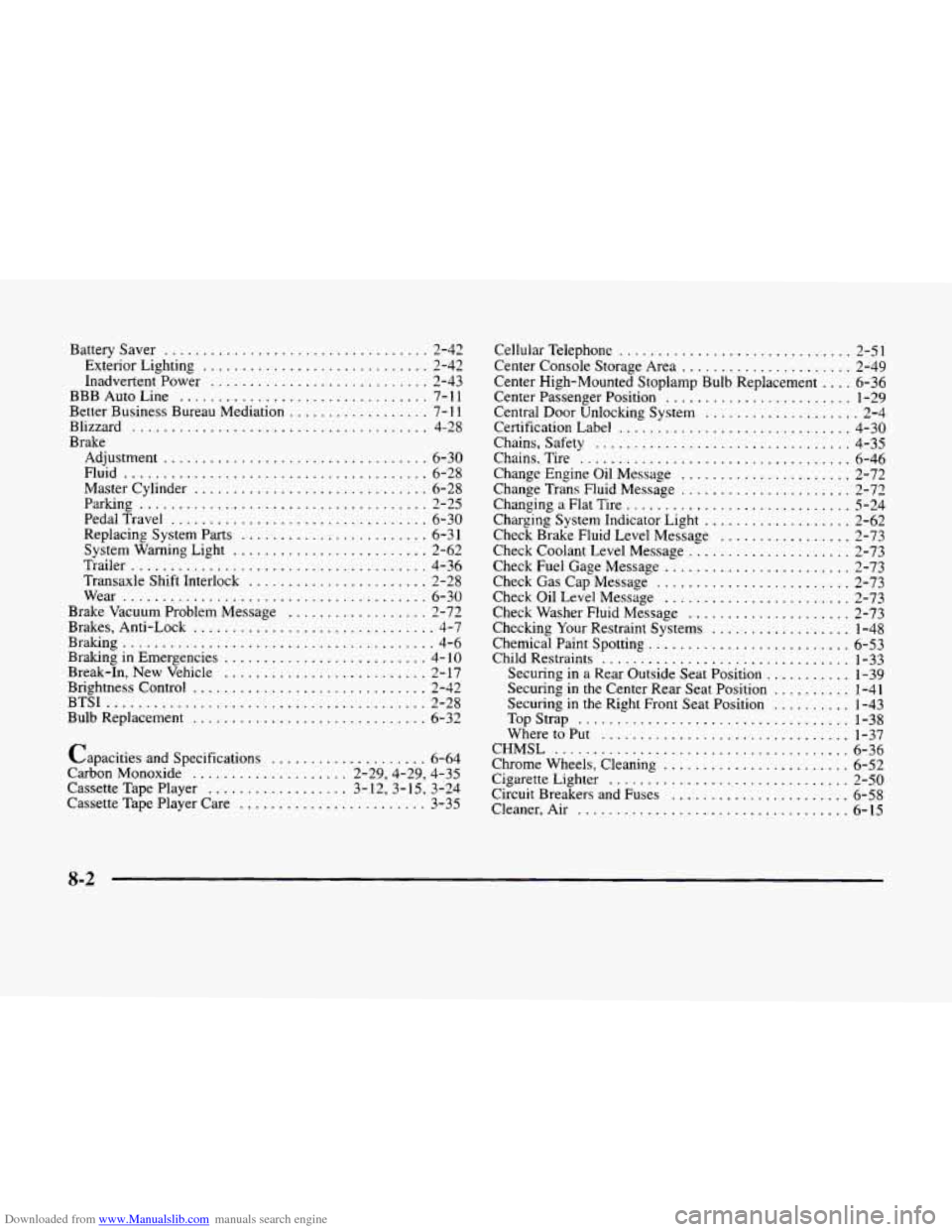
Downloaded from www.Manualslib.com manuals search engine BatterySaver .................................. 2-42
Exterior Lighting
............................. 2-42
Inadvertent Power
............................ 2-43
BBB Auto Line
................................ 7-1 1
Better Business Bureau Mediation .................. 7-1 1
Blizzard ...................................... 4-28
Brake Adjustment
.................................. 6-30
Master Cylinder
.............................. 6-28
Replacing System Parts
........................ 6-31
System Warning Light
......................... 2-62
Trailer
...................................... 4-36
Transaxle Shift Interlock
....................... 2-28
Brake Vacuum Problem Message
.................. 2-72
Brakes, Anti-Lock
............................... 4-7
Braking
........................................ 4-6
Braking in Emergencies .......................... 4- 10
Break-In, New Vehicle
.......................... 2-17
Brightness Control
.............................. 2-42
Bulb Replacement
.............................. 6-32
Fluid
....................................... 6-28
Parlung
..................................... 2-25
PedalTravel
................................. 6-30
Wear
....................................... 6-30
BTSI ......................................... 2-2 8
Capacities and Specifications
.................... 6-64
Carbon Monoxide
.................... 2.29.4.29. 4.35
Cassette Tape Player .................. 3- 12. 3. 15. 3.24
Cassette Tape Player Care
........................ 3-35 Cellular Telephone
.............................. 2-5 1
Center Console Storage Area ...................... 2-49
Center Passenger Position
........................ 1-29
Central Door Unlocking System
.................... 2-4
Certification Label
.............................. 4-30
Chains. Safety
................................. 4-35
Chains.Tire
................................... 6-46
Change Engine Oil Message ...................... 2-72
Change Trans Fluid Message
...................... 2-72
Changing
a Flat Tire ............................. 5-24
Charging System Indicator Light
................... 2-62
Check Brake Fluid Level Message
................. 2-73
Check Coolant Level Message
..................... 2-73
Check Fuel Gage Message
........................ 2-73
Check
Gas Cap Message ......................... 2-73
Check Oil Level Message
........................ 2-73
Check Washer Fluid Message
..................... 2-73
Center High-Mounted
Stoplamp
Bulb Replacement .... 6-36
Checking Your Restraint Systems
.................. 1-48
Chemical Paint Spotting
.......................... 6-53
Child Restraints
................................ 1-33
Securing in a Rear Outside Seat Position ........... 1-39
Securing in the Center Rear Seat Position
.......... 1-41
Securing
in the Right Front Seat Position .......... 1-43
TopStrap
................................... 1-38
WheretoPut
................................ 1-37
CHMSL
...................................... 6-36
Chrome Wheels. Cleaning
........................ 6-52
Cigarette Lighter
............................... 2-50
Circuit Breakers and Fuses
....................... 6-58
Cleaner. Air ................................... 6-15
8-2
Page 370 of 380

Downloaded from www.Manualslib.com manuals search engine Power Accessory. Retained
........................... 2- 18
Antenna Mast Care
............................ 3-37
DoorLocks
................................... 2-5
Remote Control Mirror
........................ 2-47
Seat ......................................... 1-2
Steering
.................................... 4-10
Steering Fluid
................................ 6-26
Windows
................................... 2-31
Windows and Other Power Options
............... 6-56
Powerseat
..................................... 1-2
Lumbar Controls
.............................. 1-3
Memory Function
.............................. 1-3
Pregnancy, Use of Safety Belts .................... 1 - 19
Problems on the Road
............................ 5- 1
Program Pass Key Message
....................... 2-75
Programmable Automatic Door Locks
.......... 2-5. 2-80
Publications, Service and Owner
.............. 7-13, 7- 14
Pull-Down Feature, Automatic
.................... 2- 12
Radio Personalization
.......................... 3-32
Radio Reception
................................ 3-34
Radio Theft-Deterrent Feature
..................... 3-33
Radios
............................. 3.10.3.13. 3.18
Rain. Driving In
................................ 4- 18
Rainsense Wipers
............................... 2-34
RAP ......................................... 2-18
ReadingLamps
................................ 2-43
Rear Compartment Fuse Block
....................... 6-62
Outside Seat Position
.......................... 1-26
Seat Passengers
.............................. 1-26 Storage
Armrest
.............................. 2-50
Window Defogger
............................. 3-8
Towing
................................. 5.9. 5.13
Rear
Turn Signal Lamps/ Taillamp Bulb Replacement . . 6-37
Rearview Mirrors
.......................... 2.44. 2.45
Recirculation
................................... 3-5
Reclining Front Seatbacks
......................... 1-4
Refrigerants. Air Conditioning
.................... 6-65
Fuel Door Release
............................. 6-6
Keyless Entry
................................. 2-6
Trunk Release ................................ 2-10
Remote Recall Memory
.......................... 2-82
Remove Key Message
........................... 2-75
Bulbs
...................................... 6-64
Normal Maintenance Parts
...................... 6-65
Wheel
...................................... 6-45
Remote
Replacement
Replacing Safety Belts
............................ 1-48
Reporting Safety Defects
.................... 7- 12. 7-13
Restraints
Checking
................................... 1-48
Child
....................................... 1-33
Head
........................................ 1-5
Replacing Parts After a Crash
................... 1-48
Retained Accessory Power
........................ 2-18
Reverse. Automatic Transaxle
..................... 2-22
Right Front Passenger Position
.................... 1-20
RKE Personalization Features
..................... 2-81
Roadside Service ................................ 7-5
Rocking Your Vehicle ........................... 5-36
Rotation. Tires
................................. 6-40
8-8